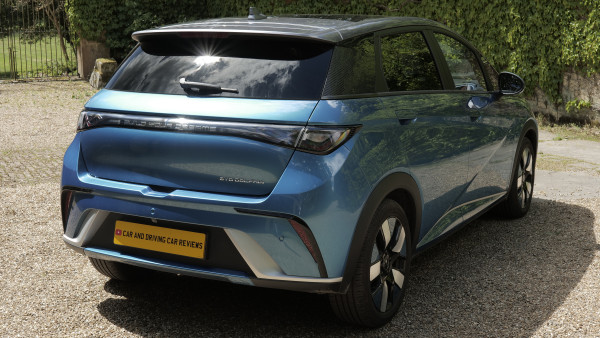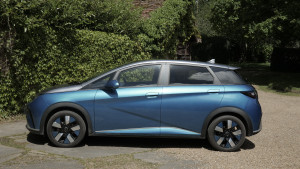The BYD Dolphin aims to revitalise the segment for small EV hatches. Jonathan Crouch drives it.
Ten Second Review
Chinese maker BYD gets serious about the British market with this small EV hatch, the Dolphin. It looks better value and more practical than the established class alternatives. And there are a few quirky touches too.
Background
It's about time we had a wider range of more affordable supermini-sized EVs and at last, it looks like the choice is widening. Here's the BYD Dolphin, a cheerily named contender to take on established class favourites like the Vauxhall Corsa Electric and the Peugeot E-208. As well as impending new ones like the reborn Renault 5.
Theoretically, it ought to be called the 'Atto 2' because it slots in below the mid-sized Atto 3 Crossover in the Chinese maker's range. But having chosen that conservative naming policy for the Atto 3, the brand has subsequently decided that a more youthful, exuberant feel is needed for its EVs. Hence this Dolphin, which sits above a small citycar-sized EV model so far only available in China (the Seagull). Keeping with the marine theme, BYD also has the Seal mid-sized EV saloon. But Dolphins are our focus here. What's this one like? Let's see.
This of course is just the start of BYD's product offensive, overseen by a UK dealer network that'll grow from around 30 to about 100 outlets by 2025. By then, we may also be seeing this Shenzhen-based company's Yangwang premium EV brand, which will bring us luxury sports cars and SUVs.
Driving Experience
Small hatches may have got vastly more expensive as EVs, but they've also got a lot faster too. With the top two spec levels, 'Comfort' and 'Design', the Dolphin's front-mounted motor puts out more power than most likely owners will possibly need - 204PS, with 310Nm of torque - and dispatches 62mph in just 7s. It draws from a 60.4kWh battery good for a WLTP-rated range of 265 miles. Two variants with a smaller 44.9kWh battery sit at the bottom of the range, the entry-level 'Active' version using a 95PS motor and offering 211 miles of range. The mid-level 'Boost' 44.9kWh model has a 176PS motor and offers 193 miles of range.
Both the available batteries feature a uniquely-dense 'Blade'-style construction. Underneath the car is the same modular 'e-Platform 3.0' chassis used by the brand's larger Atto 3 and Seal models. And, like all EVs, this one makes a noise at low speeds. The difference here though, is that you can alter the sort of low-speed noise it makes - either a conventional ambient hum or, more joyfully, a sound like a tinkling ice cream van. Which you'll either find endearing or annoying.
Don't expect anything particularly dynamically engaging on the move, but multi-link rear suspension is fitted above base trim and the Dolphin does give you four drive modes - 'Sport', 'Normal', 'Snow' and 'Eco' - which alter throttle response and steering weight. You'll need 'Sport' of course to make the car feel in any way energetic. Or to approach the modest top speed of 99mph; that's for most models; the base 'Active' version manages just 93mph. Across the range, expect the usual impressive EV refinement. And ride quality tuned appropriately for comfort, rather than careering about.
Design and Build
Whether or not you like the look of this Dolphin will be a matter of personal preference but there's no doubt it's been sized cleverly, length-wise splitting the difference between a Peugeot E-208 and Volkswagen ID.3. Just the kind of thing many customers might be looking for, provided they're not seeking any sort of Crossover vibe because (refreshingly) there's none of that here.
You might rightly conclude that this BYD's most obvious rival, the MG 4, is a little more arresting to look at, but the Dolphin is an arguably more engaging thing inside. It doesn't feel cheap, thanks to a dashboard covered in soft-touch plastics and vegan leather. Plus there are some bright colour combinations and a few eccentric touches, like door handles modelled on a dolphin's flipper. And BYD's party piece, a revolving 12.8-inch touchscreen infotainment system that at the press of a button turns from landscape to portrait.
Rather impressively, power-operated seats are standard on all variants. And there's a surprising amount of rear seat space - considerably more than you'd get in an MG4; a six-footer could sit behind a similarly-sized driver in relative comfort, which wouldn't normally be the case in a car of this size. Luggage space though, is restricted to 345-litres (less than an MG4) and isn't embellished by any further space beneath the bonnet. The boot has a removable floor panel under which you can hide the charging leads. Fold the rear bench and up to 1,310-litres of space becomes available.
Market and Model
As with the Atto 3, BYD isn't looking to substantially undercut its main competitors on price but the Dolphin still looks decent value. You can expect starting pricing starting from around £25,500 - a fraction below this model's direct Chinese EV rival, the MG4. There are four trim levels, with base 'Active' spec really only for urban folk, using the smaller 44.9kWh battery and the feeblest 90PS motor. Next up is 'Boost'-spec, which mates the 44.9kWh battery with a faster 176PS motor. The plusher 'Comfort' and 'Design' specs both use the larger 60.4kWh battery from the brand's larger Atto3 model, mated in the Dolphin with the same 204PS motor as used in its larger showroom stablemate.
BYD's big market advantage is that, unlike other brands, it makes all its EV drivetrain components itself: batteries, motors, control units, semiconductors - the lot. Which is why instead of waiting months for your car, as is currently the case with EVs from some other brands in this segment, a Dolphin can be with you in no more than a couple of weeks.
And it'll be very well equipped. Avoid entry trim and you get 17-inch alloy wheels and multi-link rear suspension. Stretch to top 'Design'-spec and you'll get a panoramic roof, Two-Tone 'Colour Palette' paint work, 'Tri-colour' alloy wheels, privacy glass in the rear seats and wireless smartphone charging. Plus a Vehicle-to-Load function that allows you to charge external devices (like, say, a camping light or an EV bike) directly from the car.
Across the range, there are features like LED headlamps and tail lights. Plus a huge 12.8-inch central touchscreen with 4G Internet access and the company's 'BYD DiLink' suite of media systems. There's also an 8-year 'Cloud service' that gives you 1.5Gb of data per month for free for the first two years. Expect a wide range of camera safety features too.
Cost of Ownership
As with the Atto 3, the battery used here is of the unique-to-BYD lithium-ion-phosphate 'Blade' variety, which incorporates cells mounted in the strips directly to the pack. Which, the Chinese maker says, allows for a much higher cell density than a conventional battery could offer. So a much higher driving range then? Afraid not. The 265 mile range you get with the 60.4kWh battery is reasonably class-competitive, but way off being class leading (a 64kWh MG4 manages 281 miles and a Hyundai Kona Electric manages 304 miles for instance). BYD claims an efficiency figure of 4.4 miles per kWh; expect more like 3.5 miles per kWh in the real world. To preserve driving range in cold conditions, a heat pump is standard. Obviously, the driving range drops quite a lot with the smaller 44.9kWh battery - to 211 miles with the 'Active' version and 193 miles with the 'Boost' variant.
You'd think that BYD building, designing and owning this car's entire set of EV drivetrain components (including battery and semiconductors) would allow the company to make the Dolphin the first car in its segment to offer a truly modern 800V electrical architecture capable of allowing charging with the new breed of ultra-rapid DC public chargers. But no, it's the same conventional 400V system as everyone else uses - and with the bigger battery, there's an 11kW on-board charger which, when connected to a public 150kW DC charger allows the Dolphin to be charged to a modest maximum of 88kW. At that speed, a 30-80% boost takes 29 minutes. Quite a few competitors can do a 10-80% charge in that kind of time though. An AC charge from a home 7kW single-phase wallbox with the bigger battery takes 9 hours and 42 minutes from empty to full. If you can use an 11kW 3-phase charger, that figure falls to six and a half hours. If you're looking at a cheaper Dolphin with the smaller 44.9kWh battery, bear in mind that it can only charge from an AC source at up to 7kW and can only power from a public DC charger at up to 60kW.
Summary
The Atto 3 may have been BYD's first car in our market but the Dolphin is undoubtably the model that will establish this well-funded but fledgling Chinese brand. Yes, there's a big step up in price for one of these if you're graduating on from a combustion-powered small hatch. At the same time though, we can't help but think that many of the people currently paying up to £10,000 or so more for only fractionally larger compact EV hatches like the Kia Niro EV and the Volkswagen ID.3 would probably be just as happy in a Dolphin.
So should you take the plunge with one of these? If you don't care about choosing an unknown brand and can work around the restraints of the company's still rather restricted dealer network, then a Dolphin certainly ought to make the shortlist of someone in search of a small EV hatch. It's a car that sets out to flip a few established norms; and you might like it for that.





























